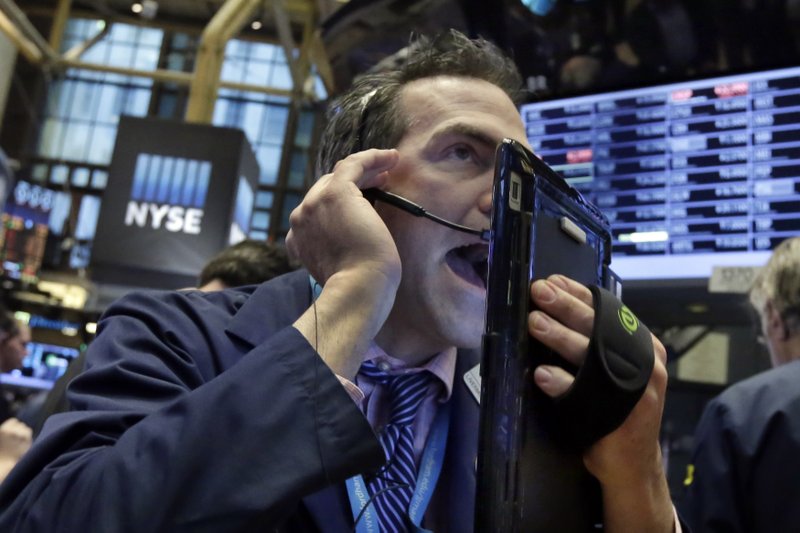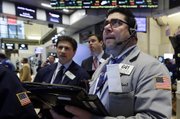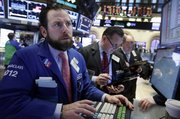NEW YORK -- A late rally lifted stock prices from a nose dive Wednesday as the price of oil took its biggest one-day plunge since September.
A huge sell-off earlier in the day pushed the Dow Jones industrial average down more than 560 points, but the index recovered, falling 249.28 points, or 1.6 percent, to 15,766.74.
Investors are worried that low oil prices are a sign that growth in the global economy is slowing.
U.S. crude dropped $1.91, or 6.7 percent, to $26.55 a barrel in New York. That was the biggest one-day decline for U.S. oil since Sept. 1. U.S. crude is down 28 percent in 2016 and is trading at its lowest level since May 2003. Brent crude, a benchmark for international oils, fell 88 cents, or 3.1 percent, to $27.88 a barrel in London.
Economists say the fundamentals of the U.S. economy remain solid, particularly compared with many other nations', and that the market's recent losses are an overreaction. The Dow has fallen 9.5 percent this year.
"The sell-off is simply happening too fast, which signals panic selling, more than reasoned investment decisions based on fundamentals like the economy and corporate earnings, are driving these losses," said Chris Rupkey, chief economist at Union Bank in New York. "It can't last."
However, continued volatility in the stock market risks damaging the confidence of consumers and businesses and pushing the U.S. more quickly toward an economic downturn, economists say.
"There are a lot of things behind" the sell-off, Stephen Schwarzman, chief executive officer of Blackstone Group LP, said in a Bloomberg TV interview from Davos, Switzerland.
"You have economic things such as the slowing of the U.S. economy, which has been pretty gradual. You've got energy going down so quickly that you can almost get windburn. You've got China as an issue, which is is probably overdone. So when you put those factors together you have an unattractive brew."
Even with the final-hour rebound, the selling remained broad-based, with six of the 10 main groups in the Standard & Poor's 500 index falling at least 1.3 percent.
The S&P 500 fell 22 points, or 1.2 percent, to 1,859.33. The Nasdaq composite, which briefly turned positive in the afternoon, fell 5.26 points, or 0.1 percent, to 4,471.69.
"Everybody has been perched on the edge of their chair waiting to see a capitulation day, in which you get a really steep flush in equities," said Mark Luschini, chief investment strategist in Philadelphia at Janney, which oversees about $68 billion. "That's usually indicative of a point where a market may stage a reversal, and we had that today."
James Liu, global market strategist for JPMorgan Funds, said demand for oil hasn't fallen off and the global economy remains relatively healthy.
But oil companies are still producing a great deal of crude, he said, so tremendous stockpiles have accumulated. While companies started shutting down drilling rigs and wells in late 2014 after prices started to decline, production of oil didn't change much.
Liu predicted production will keep falling and oil prices will stabilize in the middle of 2016, then start rising.
"I think that will alleviate some market concerns," Liu said.
The falling price of oil is bad news for companies that drill for oil and sell it, and those companies have cut jobs and slowed work to reduce their costs. Banks have lent billions of dollars to energy companies to fund their work, and investors are worried the banks won't get their money back. It's good news, however, for car owners and for companies that use a lot of fuel.
Energy stocks were pelted. Devon Energy lost $1.89, or 8 percent, to $21.49, and Exxon Mobil sank $3.22, or 4.2 percent, to $73.18. Financial stocks were also hit because banks could lose billions on loans to oil and gas companies. Bank of America shares fell 55 cents, or 3.9 percent, to $13.69.
Gold and U.S. government bonds, traditional havens, rose in value as investors shifted money out of stocks.
Overseas markets also fell. Japan's Nikkei index entered a bear market, down 20 percent from its peak in June, and European benchmarks lost between 3 percent and 4 percent.
Jack Ablin, chief investment officer of BMO Private Bank, said he thinks stocks will fall a bit further, but he doesn't expect a global collapse. Ablin said that for years, investors bought stocks without too much regard for risk.
He said investors felt that if things ever got too bad, the Federal Reserve would help prop up the market.
"Investors were comfortable taking outsize risks, not because they had earnings to fall back on, but because they had the Fed to fall back on," Ablin said. So stocks made huge gains in the years since the financial crisis while the U.S. economy churned out years of steady but unspectacular growth.
Commercial tech giant IBM said its revenue fell for the 15th-consecutive quarter. Sales fell about $170 million short of Wall Street forecasts. The stock shed $6.25, or 4.9 percent, to $121.86, for the biggest loss in the Dow average.
Health care stocks rose, led by biotech drugmakers. Celgene added $4.50, or 4.4 percent, to $107.49, and Amgen picked up $3.72, or 2.5 percent, to $155.02.
Spirit Airlines said its profit margins will be stronger than expected and costs for aircraft rent, maintenance and other items will be smaller. Its shares rose $4.10, or 10.8 percent, to $42, the biggest jump in two years. The plunge in energy prices has also helped airlines save money on jet fuel.
U.S. government bond prices rose as traders shifted money into lower-risk investments. The yield on the 10-year Treasury note dropped to 1.99 percent, its lowest level since October, from 2.06 percent a day earlier.
That yield, which is a benchmark for setting interest rates on home mortgages and other kinds of loans, has fallen sharply since the beginning of the year. At the end of 2015 it stood at 2.3 percent.
The price of gold rose $17.10, or 1.6 percent, to $1,106.20. While gold is far below its prices from the financial crisis, it's up 4 percent in 2016. The price of silver added 3.9 cents to $14.16 an ounce and is up almost 3 percent for the year. Copper slipped 1.8 cents to $1.96 a pound and is down 8 percent for the year.
Information for this article was contributed by Marley Jay of The Associated Press; by Dani Burger, Anna-Louise Jackson and Jeremy Herron of Bloomberg News; and by James F. Peltz and Jim Puzzanghera of the Los Angeles Times.
A Section on 01/21/2016


